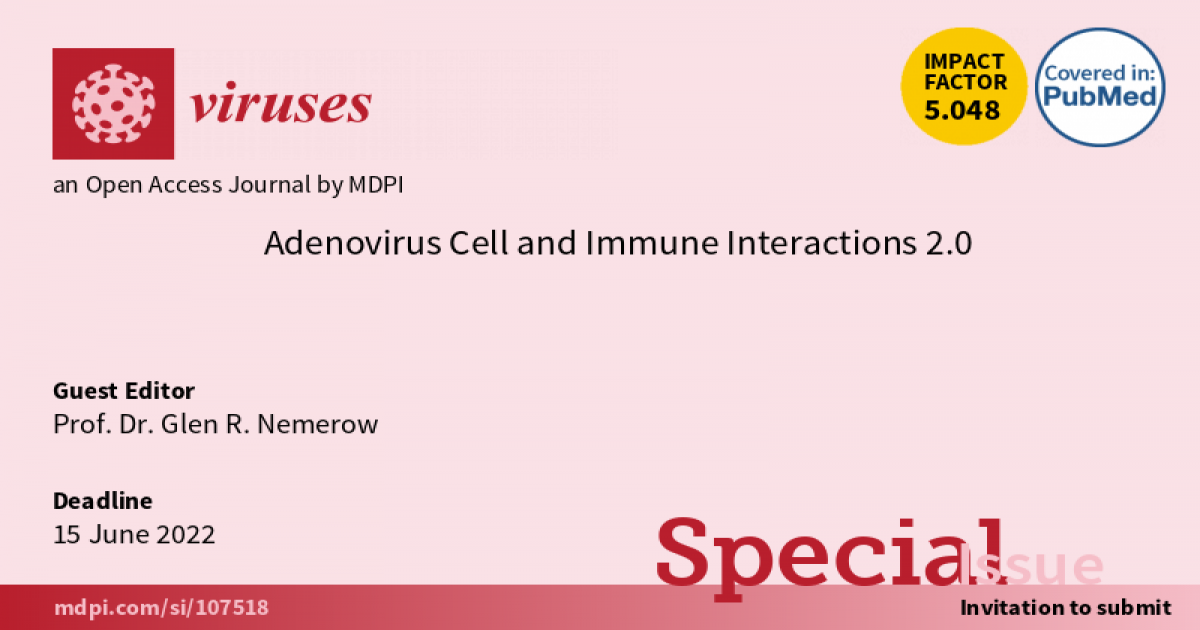Adenovirus Cell and Immune Interactions 2.0
A special issue of Viruses (ISSN 1999-4915). This special issue belongs to the section "Viral Immunology, Vaccines, and Antivirals".
Deadline for manuscript submissions: closed (15 June 2022) | Viewed by 11432

Special Issue Editor
Interests: virus-host receptor interactions; adenovirus structural biology; adenovirus-innate immune interactions
Special Issues, Collections and Topics in MDPI journals
Special Issue Information
Dear Colleagues,
Ever since their discovery in the early 1950s, human adenoviruses (HAdVs), the cause of respiratory diseases of young children, have been the subject of intense basic research as well as efforts to engineer HAdV vectors to ameliorate human diseases. Although much information has been gleaned over the past 67 years from laboratory and clinical investigations, we still have an incomplete picture of the critical associations of HAdV with host cells and specific components of the immune system. An ability to uncover additional information will likely influence the future success (or failure) for exploiting HAdV vectors for gene and vaccine therapies.
Each contribution in this series will highlight the efforts and progress made to acquire basic knowledge of adenovirus host interactions and will indicate particular areas that remain to be uncovered. Topics in this new series include key steps in HAdV–host cell entry and immune interactions as well as structure-based investigations of virus and virus capsid protein associations with cell receptors and innate immune molecules. Involvement of HAd in human diseases such as ocular pathogenesis will be also described. Genetic and chemical approaches to alter the Ad capsid to avoid immune interactions as well as structural and functional analyses of “immunoprivileged” HAdV26 and HAd49 vaccine candidate vectors will also be discussed.
Prof. Dr. Glen R. Nemerow
Guest Editor
Manuscript Submission Information
Manuscripts should be submitted online at www.mdpi.com by registering and logging in to this website. Once you are registered, click here to go to the submission form. Manuscripts can be submitted until the deadline. All submissions that pass pre-check are peer-reviewed. Accepted papers will be published continuously in the journal (as soon as accepted) and will be listed together on the special issue website. Research articles, review articles as well as short communications are invited. For planned papers, a title and short abstract (about 100 words) can be sent to the Editorial Office for announcement on this website.
Submitted manuscripts should not have been published previously, nor be under consideration for publication elsewhere (except conference proceedings papers). All manuscripts are thoroughly refereed through a single-blind peer-review process. A guide for authors and other relevant information for submission of manuscripts is available on the Instructions for Authors page. Viruses is an international peer-reviewed open access monthly journal published by MDPI.
Please visit the Instructions for Authors page before submitting a manuscript. The Article Processing Charge (APC) for publication in this open access journal is 2600 CHF (Swiss Francs). Submitted papers should be well formatted and use good English. Authors may use MDPI's English editing service prior to publication or during author revisions.
Keywords
- adenovirus
- gene therapy
- ad vaccine
- innate immune system
- respiratory disease
Benefits of Publishing in a Special Issue
- Ease of navigation: Grouping papers by topic helps scholars navigate broad scope journals more efficiently.
- Greater discoverability: Special Issues support the reach and impact of scientific research. Articles in Special Issues are more discoverable and cited more frequently.
- Expansion of research network: Special Issues facilitate connections among authors, fostering scientific collaborations.
- External promotion: Articles in Special Issues are often promoted through the journal's social media, increasing their visibility.
- e-Book format: Special Issues with more than 10 articles can be published as dedicated e-books, ensuring wide and rapid dissemination.
Further information on MDPI's Special Issue polices can be found here.
Related Special Issue
- Adenovirus Cell and Immune Interactions in Viruses (11 articles)






